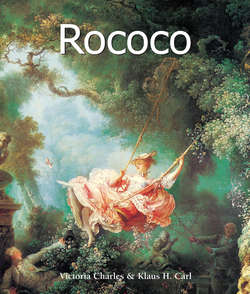Читать книгу Rococo - Victoria Charles - Страница 2
На сайте Литреса книга снята с продажи.
Contemporary History
ОглавлениеFrançois Boucher, The Toilet of Venus, 1751.
Oil on canvas, 108.3 × 85.1 cm.
The Metropolitan Museum of Art, New York.
Jacopo Amigoni, Flora and Zephyr, 1748.
Oil on canvas, 213.4 × 147.3 cm.
The Metropolitan Museum of Art, New York.
In the first quarter of the 18th century, in a barely noticeable transition, Baroque gave way to Rococo, also known as the late Baroque period. The unstoppable victory parade of the Age of Enlightenment, which began with the Reformation and the Renaissance, continued its unwavering march until the end of the 17th century in England, inching inexorably towards its climax, and throughout the 17th century formed the intellectual and cultural life of the entire 18th century. With this, the educated and prosperous bourgeoisie began to discuss works of art which had hitherto been largely left up to the nobility and the royal courts. If up until that point the clientele for architecture or paintings was drawn predominantly from the church and to a lesser extent from the nobility, and the artists were regarded rather as artisans organized into guilds, they now became individuals with independent professions. At the same time the artist was no longer obligated to create portraits or works based on mythology in accordance with never-changing, prescribed themes and commissions.
The most important instrument of the Enlightenment was prose, which was given a witty, inspirational, entertaining and universally comprehensible form in letters, pamphlets, treatises and historical works, since only these were able to reach the broad mass of the population. In France, between 1751 and 1775, the 29 volumes of the Encyclopédie were published jointly by Denis Diderot (1713–1784), Jean-Jacques Rousseau (1712–1778), Jean-Baptiste le Rond (1717–1783), who called himself d’Alembert, François Marie Arouet (1694–1778), and the self-styled Voltaire. This encyclopedia encompassed not only the whole of human knowledge but also made available a collection of arguments against the fossilization of learning.
Hubert Robert, Demolition of the houses on the Pont Notre-Dame in 1786, 1786.
Oil on canvas, 73 × 140 cm.
Musée du Louvre, Paris.
Absolutism was the norm, in an era in which rulers possessed unbridled power over their territories and were able to govern without any external controls or any obligation to their subjects. The instruments at their disposal were first and foremost the army, the Legislature with its officials bound by ties of unconditional obedience, the Church and finally the mercantile trading system. This era ended in France around the time of the death of Louis XIV (1715).
